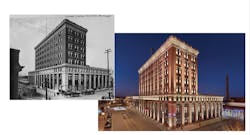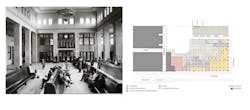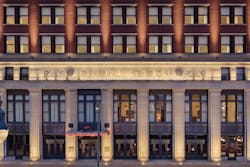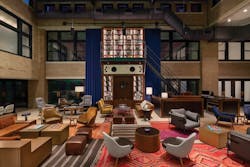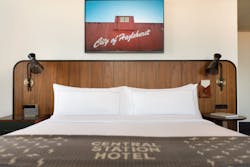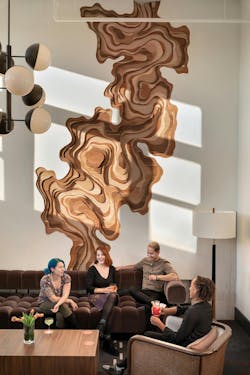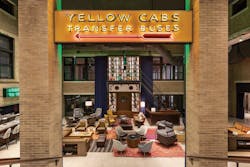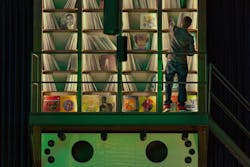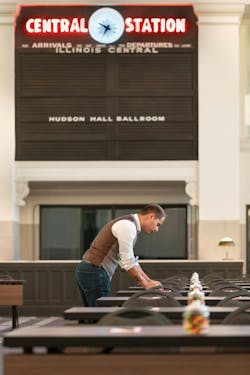Memphis, "The Home of the Blues," gets a hotel worthy of its musical heritage
The new Central Station Memphis hotel, part of the Curio Collection by Hilton, draws on the city's music, artistic, and architectural legacy to create an Instagram-friendly destination for residents and visitors to the Home of the Blues.
Central Station porte-cochère with century-old buffer posts in place. Photo: VRX Studios
The developer, Memphis native McLean Wilson, Principal of Kemmons Wilson Companies, had a distinct vision for the project: to create an authentic music and cultural experience that would bring local residents and tourists to the city's historic South Main Arts District. Wilson, the grandson of Holiday Inn founder Kemmons Wilson, was the financial genius behind the award-winning restoration of the 1.5 million-sf Sears Distribution Center into Crosstown Concourse (https://www.bdcnetwork.com/crosstown-concourse-organic-urban-village).
But structural problems in the century-old terminal, coupled with the absolute requirement to maintain Amtrak service for the legendary City of New Orleans line operational during construction, raised questions as to whether reconstruction of Central Station was even physically feasible.
Memphis Central Station waiting room ca. 1915 and floor plan. Images: Courtesy LRK
A BUSTLING RAIL HUB BETWEEN CHICAGO AND NEW ORLEANS
The eight-story Memphis Central Station (originally known as Grand Central Station) opened on October 4, 1914, as a bustling rail hub with upper-story offices for the Illinois Central Railroad. As rail travel declined, it served as a precinct for the Memphis Police Department and wholesale the upper floors of the landmark building were converted into small apartments.
In April 2017, the project team, led by Robins & Morton (GC) and design firms LRK (design architect) and Bounds and Gillespie Architects (executive architect), conducted what they thought would be a routine assessment of the existing conditions in the monumental 103,000-sf edifice. They were startled to discover that:
- The station’s public floors jogged in height from one floor to another, the uneven levels smoothed only by makeshift stairs and ramps.
- A $23 million renovation by the Memphis Area Transit Authority in 1998 converted the station waiting area into a large function room, taking up space that the new design team needed for dining, hospitality, bar, and lobby experiences.
- The building had only one small working elevator.
- There was almost no documentation of original as-built conditions. “We had no idea what was behind the walls,” said structural engineer Chad Evans, Project Manager with Bounds & Gillespie Architects.
- The ceiling in what was planned to become the kitchen was just seven feet high.
On the plus side, many unique features remained in place: a graceful brick and limestone exterior, terra cotta limestone trim, intact upper-level windows, original marble floors, a grand staircase, and the station’s signature arrival and departure board.
The project team engaged in a full-year preconstruction study to analyze options, evaluate opportunities, and somehow resolve these roadblocks.
Exterior architectural lighting enlivens the hotel at night, highlighting the massive limestone frieze and other historic features. The interior spatial arrangements of the historic arrival halls and concourses remain intact. PHOTO: VRX STUDIOS
RECONFIGURING THE OUTDATED STRUCTURAL SYSTEM
The most significant unknown had to do with the building's structural system. “The materials and methods used in the 1914 construction severely limited the options for restoring the main structure,” said Robins & Morton Assistant Project Manager Matt Preisz. “It was much different than the traditional structure we expected to see.”
This structural system, which apparently was frequently used in the early 1900s in the Memphis area, involved forming terra cotta blocks into a slight arch to underpin each floor and support the walls. “The blocks would press toward each other in the arch to form a tight support system,” said Danny Bounds, AIA, Principal, Bounds & Gillespie. “This allowed the entire structure to hold up weight and pressure from above, in lieu of beams and girders.” Concrete was then poured on top of the terra cotta to form the floors. Given the delicate nature of the structural system, the project team feared that any damage to the terra cotta might bring down the whole structure.
Rather than razing the building and starting from scratch, the Central Station team vowed to restore the stately edifice.
The 8 and Sandy lobby bar at Central Station Memphis. Photo: VRX Studios
The arduous process began with a 3D laser scan of the entire building, which revealed missing or compromised terra cotta blocks and previously hidden flaws in the walls, ceilings, floors, and structure. Structural engineers Davis Patrikios Criswell defined the bearing points where the terra cotta could safely be penetrated. The team removed large sections of the terra cotta block, one floor at a time, reframed it with a continuous structural steel support system, and poured new concrete floors.
In what was to become the hotel guest room area, several floors were out of alignment by as much as two feet. The design team reconfigured the size and layout of several of these rooms in order to accommodate utility runs and other support equipment.
Guest rooms feature large windows and high ceilings with grand views of downtown. Local photographer and visual anthropologist Jamie Harmon traveled on the City of New Orleans and photographed towns up and down the line to take unique images for each room. PHOTO: VRX STUDIOS
WORKING WITH THE HISTORIC PRESERVATION EXPERTS
As a “contributing property” to the historic South Main Arts District, Central Station had to meet preservation guidelines set by the National Park Service and the Tennessee Historical Commission (THC), on top of the usual building code requirements. Local preservation consultant Antonio R. (Tony) Bologna, FAIA, Bologna Consultants, guided the review process that permitted the installation of new guest elevators and mechanical systems.
Converting the station’s former waiting room into an up-to-date, 6,000-sf ballroom posed a much more daunting problem. The original terrazzo floor and period ceiling finishes, while in remarkably good shape, turned the room into an echo chamber. “The acoustics in the ballroom were dreadful,” Bologna said. “It was impossible to have a normal conversation, even with a person sitting right next to you.”
To dampen the noise, the team sought approval to carpet part of the room and add an acoustic plaster to the ceiling. Several tests were conducted to achieve the appropriate color and texture match for the original ceiling. The oversight entities signed off on these remedies, which greatly improved the room’s acoustics. “We had a lot of good faith negotiations [with the NPS and the THC] that allowed for creative and authentic solutions,” said Bologna.
The team used photographic evidence to make the case for other high-visibility modifications. In one such instance, a brick wall blocked views from the lobby out to the hotel’s new outdoor plaza. Bologna discovered an archival photograph that showed the area’s original layout—with no wall. Demolition was approved, opening up the space to the outdoors
THE DESIGN THEME: MUSIC, MUSIC, MUSIC
The 123-key Central Station Hotel, part of the Curio Collection by Hilton, draws on Memphis’ music legacy, historic architecture, local artists, and neighborhood ambiance to provide a distinctly Memphis experience for visitors and local residents.
In the public space, art consultant Anna Wunderlich curated every piece of art, each of which is unique to Central Station Hotel. Artists from Memphis, Chicago, and New Orleans (along the 900-mile City of New Orleans train) created pieces for the hotel’s public areas, furthering the hotel’s goal of participating in the South Main Arts District. PHOTO: VRX STUDIOS
The historic landmark, reinvigorated as a mixed-use transit center with Amtrak, light rail, bus, and a bicyle station, was designed to engage the downtown Memphis community. The décor is inspired by turn-of-the-century modern fashion and whimsical acoustic fanfare.
Lobby with EgglestonWorks speakers display. Photo: VRX Studios
“The design team focused on music as the muse with a high level of intentionality around authenticity and education,” said LRK Senior Associate and Project Manager Jonathan Smith, AIA. Developer McLean Wilson formed a collaboration with EgglestonWorks, a renowned maker of premier sound systems, which crafted customized speakers and installations for the hotel. An EgglestonWorks sound system is suspended from above the seating area in the Eight & Sand Bar.
Eight and Sand Bar and lounge area at Central Station Memphis, as well as interior and exterior neon wayfinding signs and an eye-catching iron stairway and platform, were given new life. The stairway once allowed the conductors to reach the back of the marquee and change out time and track information by hand. Photo: VRX Studios
The bar and lounge area are complemented by an impressive two-level wall of vinyl; the train station’s original ladder leads up to the second level of records. Jim Thompson, President and Chief Designer of EgglestonWorks, personally curated the collection, which consists of 2,500 LPs, a thousand 45 RPM records, and 21,000 digital tracks—more music than you could listen to in a hundred years if you listened every day, eight hours a day.
DJs spin the sounds of Memphis daily in the Eight & Sand Bar from 4 p.m. until closing. They work from “Elmertha,” a DJ booth constructed from an old church organ. Named after Booker T. Jones’s piano teacher, Elmertha Cole, the booth was hand-built for the space by EgglestonWorks’ chief designer Jim Thompson and features both vinyl turntable and digital capabilities. A daily playlist can be heard in the hotel’s common spaces and in the guest rooms. Guests receive a leather-encased daily “playlist highlights” card. Photo: VRX Studios
Behind the wall of vinyl is an unmarked soundproof Listening Lounge that seats six guests and is equipped with specially designed EgglestonWorks speakers to create a stunning auditory experience. Visitors can use touchscreens to choose episodes of the hotel’s original podcasts on Memphis styles of music, with commentary by an artist of that genre.
'A GREAT ANCHOR' FOR THE CITY'S HISTORIC ART DISTRICT
The spaces were designed and curated to ensure that Central Station Hotel would stand out against other hotels not just in Memphis area but perhaps throughout the nation. The BD+C Reconstruction Awards jury strongly agreed that the project team had achieved that goal.
The track sign was restored and posted prominently. Photo: Jamie Harmon | Amurica
RECONSTRUCTION JURY'S PRAISE FOR CENTRAL STATION MEMPHIS
Five hundred construction jobs were created. In addition to the two food/beverage outlets, the hotel employs 135. Central Station also achieved 20-25% of construction spend going to local minority- and women-owned firms.
The project earned Bronze honors in Building Design+Construction's 37th Annual Reconstruction Awards. “A great anchor in a revitalizing historic district,” said juror Suzanne Germann, of Landmarks Illinois. “Reused many of the original elements, and overcame challenges of working in an active train station.”
The station’s original arrival and departure marquee was preserved. Photo: VRX Studios
THE CENTRAL STATION MEMPHIS, CURIO COLLECTION BY HILTON | MEMPHIS, TENN.
PROJECT SUMMARY BUILDING TEAM Robins & Morton (submitting firm, GC) and LRK (submitting firm, design architect) Central Station Hotel Partners LLC (developer) Bounds & Gillespie Architects (executive architect) Looney & Associates (hotel interior designer) Collect + Curate (restaurant designer) Davis Patrikios Criswell (structural engineer) SR Consulting Engineers (civil engineer) Smith Seckman Reid (mechanical/plumbing engineer) Burns Engineering (electrical engineer) Bologna Consultants (historic preservation consultant) Loaded for Bear (environmental graphics) Plants + People (landscape designer).
DETAILS 103,000 sf Total cost Confidential at owner’s request Construction period January 2018 to October 2019 Delivery method Negotiated cost-plus with GMP contract
